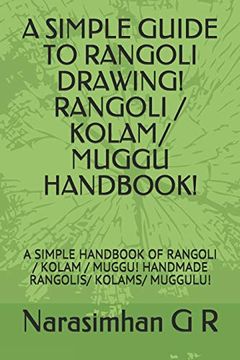Reseña del libro "A Simple Guide to Rangoli Drawing! Rangoli (en Inglés)"
Rangoli/ Kolam (or Muggu) - A conventional Indian adornment and examples made with ground rice, especially during celebrations. Rangoli is gotten from the Sanskrut word 'rangavalli'. Rangoli is a craftsmanship which goes before figure and painting. It is both a promising and a starter need in any religious custom. It is a custom to draw rangoli at the site of any promising religious custom, for example, a blessed celebration, a religious celebration, a propitious capacity like wedding, ceremonial love, a pledged religious recognition, and so on. Rangoli is a fine art, beginning in the Indian subcontinent, in which examples are made on the floor or the ground utilizing materials, for example, hued rice, dry flour, shaded sand or blossom petals. It is generally made during Diwali or Tihar, Onam, Pongal and other Hindu celebrations in the Indian subcontinent. Plans are passed starting with one age then onto the next, keeping both the work of art and the custom alive. Generally in temples, home, celebrations, pooja rooms, marriages, birthdays or any other important places; rangolis are drawn. The reason for rangoli is enhancement, and it is thought to bring good karma. Structure delineations may likewise differ as they reflect conventions, old stories, and practices that are interesting to every territory. It is customarily done by young ladies or ladies. For the most part, this training is displayed during events, for example, celebrations, favorable observances, marriage festivities and other comparative achievements and get-togethers. Rangoli structures can be basic geometric shapes, god impressions, or blossom and petal shapes (proper for the given festivals), however they can likewise be intricate plans made by various individuals. The base material is typically dry or wet powdered rice or dry flour, to which sindoor (vermilion), haldi (turmeric) and other regular hues can be included. Different materials incorporate shaded sand, red block powder and even blooms and petals, as on account of blossom rangolis. In center India mostly Rangoli is called Chaook and is commonly drawn at the passageway of a house or some other structure. Dried rice flour or different types of white residue powder is utilized for illustration Chaooks. Despite the fact that there are various conventional Chaook designs, a lot more can be made relying upon the imagination of the individual who draws it.It is viewed as favorable as it implies showering of good karma and success on the house and in the family. It isn't drawn like an image. There are two major types of Rangoli/ Kolam: 1. Dotted pattern 2. Free Pattern Dotted pattern starts by keeping dots to connect lines in rangoli/ kolam. Free patterns are without dots and the rangoli maker can start mostly from center of the kolam as per their wish. Dots are just to give perfection of lines and patters. This book is released for 100+ simple(basic), medium(intermediate) & advanced sized rangolis/ kolams which are drawn for different occasions like Diwali, Sankranthi, Ganesh Chadurthi, Ugadhi, New Year, Temple festivals etc. These kolams are not printed one; they are drawn simply with freehand. Most of the rangoli/ kolams/ muggus in this handbook are drawn with free hand in the paper or notebooks. Many others are down on the floor in our houses and temples as well. So nothing is computer generated design here. Naturally it has been pictured and cropped wherever necessary and brief description given for these designs!........MORE!

